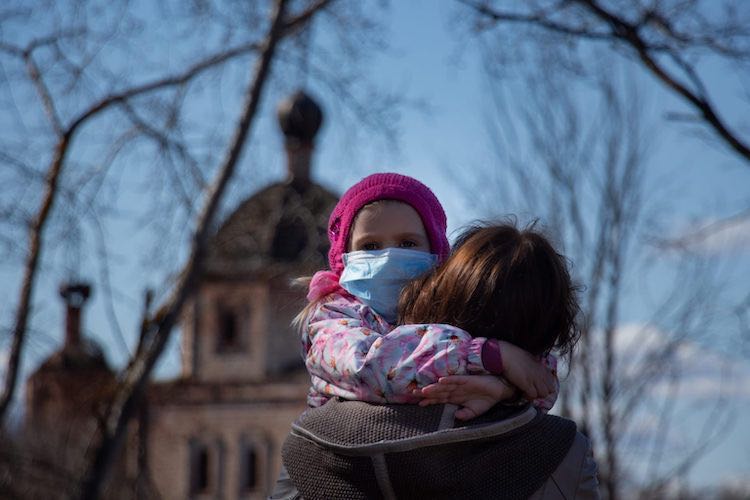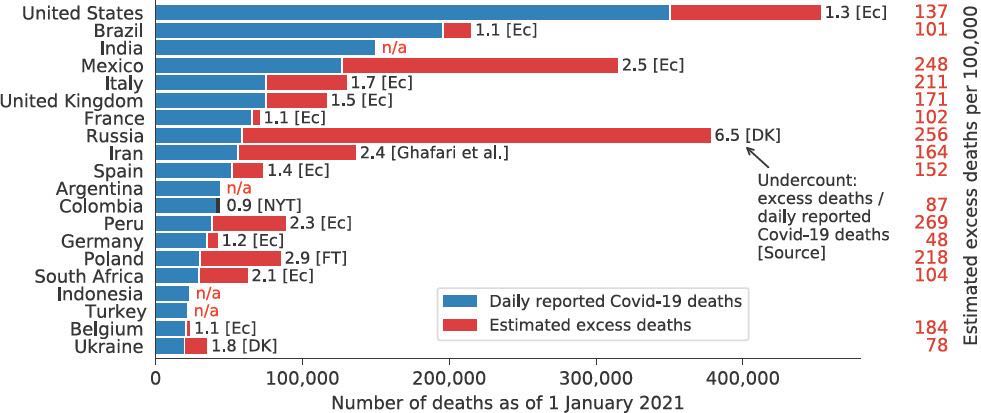Confronted with the Covid pandemic the Russian government has put economy over people and propaganda over healthcare, writes economist Sergei Guriev. These choices did help the Russian economy but they also resulted in very high excess mortality.

Picture VPeremen.com
Russian President Vladimir Putin is praising the performance of the Russian economy and healthcare system in 2020. Indeed, Russian GDP is likely to have declined in 2020 by only 4 percent. Russia’s sovereign fund, the National Welfare Fund, stands at 12 percent of GDP. Russia’s official number of COVID deaths is 60 thousand – lower than France’s in absolute numbers and hence 2.5 times as low in per capita terms. According to Mr. Putin, Russia’s vaccine Sputnik V was the first registered vaccine in the world. Russia not only has started mass vaccinations already in 2020, it has also sent 300.000 doses to Argentina.
Some of these statements are correct, some are misleading, and some are outright false. First, it is true that the economic recession will not be as deep as in Europe. While in the first half of 2020 international organizations projected a Russian GDP decline of 6, 8 or even 10 percent in 2020, they now converged back to Russia’s official forecast of 4 percent. To be more precise, the Russian government’s projections are a bit better than 4 percent decline (IMF’s October 2020 World Economic Outlook with -4.1 is slightly more pessimistic) – but much better than the numbers for the US (-4.3), the Euro area (-8.3), Japan (-5.3) or the UK (-9.8).
Economy over people
Unlike its Western counterparts, the Russian government favoured economy over people. It did not introduce a strict lockdown, nor did it offer generous support to households or small businesses. Instead of a lockdown, in April and May 2020 Russia introduced some ‘non-working weeks with preservation of wages’ – workers stopped working but their wages were paid. Restrictions during the second wave in the fall were even less severe. The total fiscal support for the economy in Russia the IMF estimated to be 3.5% of GDP, or 4.5 percent if debt guarantees and capital injections are also added. This is much less than in other G20 countries – in France, for example, the total support was 21 percent of GDP.
This low level of fiscal support explains why Russians did not stay at home neither in spring, nor fall. Apple and Google mobility data show that Russians continued working and shopping (including non-essential shopping) to a much greater extent than their European counterparts. The reason was that households could not afford staying at home and small businesses could not afford closing down. The lack of effective fiscal stimulus resulted in the decline of real household incomes by 4 percent – along with GDP. This is a huge difference from 2009 – when GDP collapsed by 8 percent but government spending helped support household income which actually grew by 2 percent.
State debt not free of charge
Why was the Russian government so stingy in 2020? The official explanation was that, unlike its Western counterparts, Russia could not borrow at zero or negative rates. This is correct. However, Russia has a 12% GDP sovereign wealth fund accumulated through oil and gas taxes in the years of high hydrocarbon prices. It was this fund that was used to support incomes in 2009. Why was it not used in 2020? The lack of a generous fiscal response may be explained by two major political factors: Vladimir Putin’s need to change the Constitution and his focus on celebrating the 75th anniversary of the Victory of World War II.
According to the Russian Constitution Putin unequivocally had to step down from the presidency in 2024 (after two consecutive terms). However, in January 2020, Putin unexpectedly through the Duma announced that he wanted to change the Constitution. In early March it became clear which changes he had in mind: in addition to further redistribution of power from prime-minister, parliament and judiciary to the president, he also introduced an amendment that would allow him to serve for two more consecutive terms after 2024. [He simply 'annulled' his previous terms of office - ed.]
In order to legitimize this change, he decided to hold a national vote on July 1. In order for the referendum to take place, however, he first had to declare victory over COVID in May. July was an important strategic choice – as his opponents, better educated and internet-savvy, would be more aware of the COVID risk and would be more likely to stay at home.
Putin’s second political priority for 2020 was the celebration of the 1945 Victory over Nazi Germany. Putin’s Russia does not have an ideology; it draws its legitimacy from Russia’s glorious past with a special role for the Soviet victory over Hitler. This is why Putin was counting on a grand military parade on 9 May – inviting high-profile international guests. President Macron was planning to come, among others. COVID destroyed those plans but Putin still had to show off and scheduled the parade for June 24. For this to happen, again he had to announce that the epidemic was over.
Excess mortality
Not surprisingly, the soft lockdown policies and the lack of economic support during the pandemic (which has also contributed to weaken social distancing) were desastrous for the health of the population. Official COVID-19 mortality numbers have been very low. The problem, however, is that these data are not credible and have been contradicted by the Russian government itself. The ultimate count is the excess mortality – the seasonally adjusted difference between mortality in 2020 and in previous years. These numbers suggest that Russian official data underreport the actual COVID deaths by a factor of six.
Even if one follows Deputy Prime Minister Golikova’s estimate that only 80% of Russia’s excess mortality should be attributed to COVID, the gap between the actual and official data would still number a factor of five – which makes Russia one of the most affected countries in the world in both absolute and relative terms. In March-November 2020, the number of deaths exceeded those from the same period of 2019 by 243 thousand.

If the numbers for December are similar to November (which is likely), the total excess mortality would be above 320 thousand. Even with the 80% adjustment Russia’s COVID death rate per capita would thus be about twice the rate in France.
But the full impact of COVID is actually bigger, as Russia's mortality trends in recent years had gone down, whereas life expectancy went up. Without COVID, Russian excess mortality in 2020 should have been negative. Russian demographer Alexei Raksha (who used to work in the Russian Statistics Agency but had to resign in summer once he started raising questions about data manipulations) estimates that even with the 80% adjustment Russia has lost about 300 thousand lives due to COVID in 2020.
Media budget instead of healthcare spending
Why did Putin’s regime opt for economy over peoples’ lives? For the answer to this question one has to understand the nature of Russia’s modern political system. The Russian regime is not an old-style dictatorship based on mass repression and fear, but neither is it a democracy. It is a new style of autocracy that my co-author Daniel Treisman and I defined as an ‘informational autocracy’, a regime based on manipulation of information, through cooptation of elites, smart censorship and sophisticated propaganda. These regimes convince the public that they are competent. It does not matter how many people really died, what matters is how many people think have died – this is why the official COVID numbers are so low. And this is why, despite the disastrous excess mortality, Putin’s approval rate remains high. While it is much lower than the 80-90% of 2014-2018, the rate is still above 60%.
This also explains why the Russian government in the 2021 budget reduces (!) healthcare spending in real terms, but keeps the state media budget intact. These choices clearly indicate the true priorities of Russian government.
Vaccination is image building
The informational nature of Russian autocracy also explains its vaccination policy. In order to prove the regime’s effectiveness, Putin boasted that Russia was the first country to ‘register’ an anti-COVID vaccine – already on August 11. He forgot to mention that at that time the Russian vaccine only completed Phase 1 and 2 clinical trials – with Phase 3 trials starting only two weeks after Putin’s announcement (by then other vaccines’ Phase 3 trials were already well underway). While Sputnik V’s Phase 3 trials were finished only at the beginning of February 2021, the Russian government announced a ‘mass vaccination’ campaign already in December 2020. Once again, what matters is using the vaccine to promote the image of the regime’s competence in the state media. Putin's own confidence in the quality of Sputnik speaks volumes: he has so far refused to get the jab. But Russian propaganda prefers not to mention this fact.
Once again, the cost of this vaccine propaganda, again, is the loss of human lives. If the government in spring 2020 diminished COVID risks for the sake of a military parade and the vote on Constitutional amendments, in the fall it decided not to introduce restrictions to underscore the fact that a reliable vaccine is allegedly already available.
These choices surely did help the Russian economy but they also resulted in very high excess mortality in the fall – and will probably contribute to additional COVID deaths in 2021.
This article was originally published at Terra Nova
